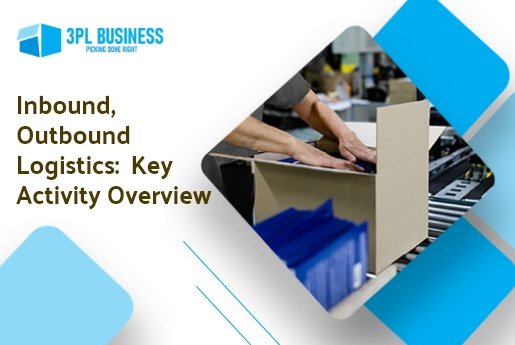
Today, businesses are focused on supply chain optimization. There are several factors contributing to the same, and inbound and outbound logistics is one of them. These processes impact profits, production, and customer service. Failure in correcting these processes will lead to losses. This is why many businesses are outsourcing them to third-party order fulfillment companies. This post explores inbound and outbound logistics in detail. It focuses on their application and benefits of partnering with third-party logistics fulfillment services for outbound logistics. Contact us today to discuss your inbound and outbound logistics requirements.
A Brief Overview of Inbound and Outbound Logistics
Inbound and outbound logistics are all about moving goods in the retail supply chain. They both involve the same set of processes; however, the only difference lies in their approach. Inbound logistics deal with supply; however, the outbound logistics deal with fulfillment. The below definitions would help you understand it better.
- Inbound Logistics: In this type of logistics, the materials or supplies are brought to the storage facility of the business.
- Outbound Logistics: In this type of logistics, the finished materials or goods are shipped to the customer locations.
Activities Involved in Inbound and Outbound Logistics
The following are a few common activities involved in inbound and outbound logistics. These may slightly differ across manufacturers, moreover, they remain the same.
Inbound
- Procurement: This step involves identifying the prospective suppliers of raw materials, securing price quotes, negotiating, and supply management.
- Purchasing or Ordering: The goods required for manufacturing are ordered in the right quantities.
- Transportation: The ordered goods are delivered to the manufacturing facility by train, truck or any public transport. Sometimes, it may also involve freight. Some businesses use their own logistics services; however, some outsource them to third-party services. The right vendor is chosen based on the price quotation, speed of delivery, mode of transport, routes covered, and many more.
- Order Matching: The logistics managers receive the orders, unload them, and carry them to the right storage location.
- Material Handling: All received goods are moved to designated areas within the facility using manual labor or different types of material handling equipment.
- Storage and Warehousing: Materials required for manufacturing are stored in logical locations for the fulfillment.
- Inventory Management: The concerned executives are responsible for managing the inventory of raw materials required for production. They know where to store these materials and how to locate them for production.
- Distribution and Tracking: The supplies are sent to pre-designated business destinations within the business. Tracking involves checking the details of the incoming orders and matching them with their receipts.
Outbound Logistics
- Receiving Order, Processing, and Fulfillment: This involves picking, validating, and packing orders as required. Many businesses outsource this step to improve their operational efficiencies, delivery speeds, profit margins, and customer satisfaction.
- Shipping: This involves shipping the order to the customer’s location. Carrier and transportation management, and last-mile delivery are some aspects of shipping.
- Customer Service: Third-party logistics fulfillment services ensure customer satisfaction through troubleshooting and order tracking services.
Benefits of Well-Planned Inbound and Outbound Logistics:
There are several benefits of implementing inbound and outbound logistics. The following pointers will help you understand it better.
- Improved Goods Flow: Inbound logistics help ensure the goods are received in the required quantities and quality at the right time, thereby reducing production delays. Outbound logistics ensure the goods are delivered to the customer on time in the right condition.
- Improved Customer Satisfaction: Whether it is delays in production or delivery, both can equally lead to frustration. Readily available raw material stock can be a delight for the manufacturer, whereas quickly delivered products can satisfy a customer. Thus, improved customer satisfaction is common to both of these types.
- Improved Sales and Revenue: As said before, a well-stocked inventory of raw goods benefits manufacturers as they can perform production and meet the customer demands easily and earn a competitive edge over other businesses. However, customers who receive their goods on time are more likely to buy again from the business, creating a win-win situation for both the manufacturer and the end-user.
- Reduced Costs: A well-planned inbound logistics helps manufacturers to save on raw material wastages and cut down their cost of operation. Similarly, it helps manufacturers and suppliers to avoid losses due to cold inventory or slow moving inventory.
Streamlining Inbound and Outbound Logistics with Third-Party Logistics Fulfillment Services
Streamlining inbound and outbound logistics with third-party logistics fulfillment services can be beneficial in many ways. The following pointers will help you understand it better.
- You need not worry about managing dead stock, transportation, warehousing and storage, etc.
- You can concentrate on core business areas like marketing, strategizing and promotions rather than focused on the challenges of logistics and supply chain management.
- Most third-party logistics fulfillment services have invested in technologies that help seamlessly integrate their platforms with the customer platforms. These technologies allow their end-users to receive updates on their inventory, storage, and shipping.

Looking for Trusted Third Party Logistics Fulfillment Services?
If that sounds yes, you can rely on the team at 3PL Business. We are experts in fulfilment. We provide a comprehensive range of eCommerce fulfillment services, including kitting and assembly, pick and pack, pick and stick, and so on. Feel free to contact our experts at (732) 983-4801 or email at sales@3plbusiness.com to inquire about our order fulfillment services, or specific requirements like custom kitting fulfillment, and so on. Our experts will happily answer your queries on inbound and outbound logistics and help you operate a successful eCommerce business.
